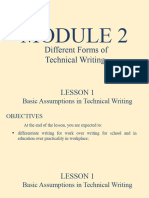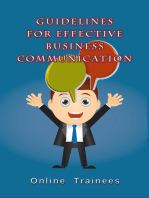Lecher #1 Eng201
Lecher #1 Eng201
Uploaded by
Muhammad ZeeshanCopyright:
Available Formats
Lecher #1 Eng201
Lecher #1 Eng201
Uploaded by
Muhammad ZeeshanCopyright
Available Formats
Share this document
Did you find this document useful?
Is this content inappropriate?
Copyright:
Available Formats
Lecher #1 Eng201
Lecher #1 Eng201
Uploaded by
Muhammad ZeeshanCopyright:
Available Formats
Introduction to Business and Technical Communication
Lecher #1 Eng201
Introduction to Business and Technical Communication
The main objective of the course is to equip the students with skills that will enable them to
Communicate clearly and concisely in diverse business situations.
کورس کا بنیادی مقصد طلباء کو ایسی صالحیتوں
سے آراستہ کرنا ہے جو ان کو قابل بنائے
متنوع کاروباری حاالت میں واضح اور مختصر طور
پر بات چیت کریں۔
The course is divided into two sections:
1. Written Communication
2. Oral Communication
Written Communication
Written Communication will cover planning, structures, and stylistic issues. The students will
Learn to write memos and letters; proposals; short and long reports; an d procedure and policy
Documents.
Oral Communication
Oral Communication section will cover the planning and execution of effective presentations;
group behavior, planning and conducting effective meetings.
A graph
A graph plotted for percentage of hours spent versus the number of people who responded to the
survey.
Writing well can bring you many personal benefits as well:
• Recognition in the form of praise
• Raises
• Promotions
BY ALONE WOLF GROUP
Introduction to Business and Technical Communication
Types of Communication
There are 5 type communications
• Memos
• Business letters
• Instructions
• Project proposals
• Progress Reports
Each on-the-job communication has its own conventions.
Ownership of a Writer’s Work
Ownership of a writer’s work is very important. While at school your communication only
belongs to you, at work however, your communication will belong only partly to you. They will belong to
your employer. What you write at work represents not only you but also y department or your
employer.
It is absolutely essential to think constantly about your readers.
There are 4 type think constantly about your readers
• Think about what they want from you and why.
•Think about the ways you want to affect them.
• Think about the ways they will react to what you have to say.
• Think about them as if they were right there in front of you while you talked together. The
communication must affect in specific ways the individuals you are addressing
As you write in a professional environment, you need to remember three things:
1. Readers create meaning.
2. Readers' responses are shaped by situation.
3. Readers react on a moment-by-moment basis.
1. Readers create meaning
BY ALONE WOLF GROUP
Introduction to Business and Technical Communication
Instead of receiving the message, people interact with the message to create meaning. While reading,
we build larger structures of knowledge from small fragments of sentences.
2. Readers' responses are shaped by situation.
Responses to a communication are shaped by a total situation surrounding the message. Such factors as
the purpose of reading the readers’ perceptions of the writer’s aims, their personal interest and stake in
the subject discussed, past relations with the writer.
3. Readers react on a moment-by-moment basis.
On job people react to each part of the memo, report or other business communication as soon as they
come to it.
BY ALONE WOLF GROUP
You might also like
- E.O. Barangay GAD Focal Point SystemDocument5 pagesE.O. Barangay GAD Focal Point SystemChristy Ledesma-Navarro95% (20)
- Tata Motors: (Standard Operating Procedure)Document16 pagesTata Motors: (Standard Operating Procedure)PRATIK BhosaleNo ratings yet
- Eng201 Short Notes by Amir For Midterm-1Document8 pagesEng201 Short Notes by Amir For Midterm-1mg8898344No ratings yet
- Effective and Engaged Business WritingDocument5 pagesEffective and Engaged Business WritingNene TapsNo ratings yet
- Persuasive and Analytical Writing For Business CommunicationDocument56 pagesPersuasive and Analytical Writing For Business CommunicationSaranjam Khan100% (1)
- Notes CS 63Document4 pagesNotes CS 63amayaNo ratings yet
- Professional Communication Module PDFDocument25 pagesProfessional Communication Module PDFapi-654101297No ratings yet
- Business Comm.Document5 pagesBusiness Comm.Erika Mae BarreraNo ratings yet
- The Business of Business WritingDocument22 pagesThe Business of Business WritingNene Taps100% (2)
- Group 5 Effective Business WritingDocument10 pagesGroup 5 Effective Business WritingPaula Mae OngNo ratings yet
- SOFT COPY (Revised)Document21 pagesSOFT COPY (Revised)Melinda SilorioNo ratings yet
- CS Lec3Document22 pagesCS Lec3aitzazat789No ratings yet
- 20MBA16-MC 3 NotesDocument35 pages20MBA16-MC 3 NotesMANJUNATHA SNo ratings yet
- Chapter 3 - Module 2 - PlanningwritingrevisingDocument48 pagesChapter 3 - Module 2 - PlanningwritingrevisingRadwan AhmedNo ratings yet
- Comm PresentSkills Lect02Document19 pagesComm PresentSkills Lect02Mohamed Adel TahaNo ratings yet
- Calderón-Geofranis-Business Communication in EnglishDocument3 pagesCalderón-Geofranis-Business Communication in Englishgeofranis.calderonNo ratings yet
- 1 Communication Skills - Meaning and ProcessDocument22 pages1 Communication Skills - Meaning and ProcessDivyanshu KumarNo ratings yet
- Different Forms of Technical WritingDocument100 pagesDifferent Forms of Technical WritingcheskajelcNo ratings yet
- JournelDocument5 pagesJournelsayenshan0205No ratings yet
- Urdu Adab TBW1Document3 pagesUrdu Adab TBW1Syed Tahir Ali ShahNo ratings yet
- Lesson 1 Utilizing Specialized Communication SkillsDocument7 pagesLesson 1 Utilizing Specialized Communication Skillsluna100% (3)
- BCommManagers 01Document31 pagesBCommManagers 01Muhammad Wali UllahNo ratings yet
- MB0039 Business Communication Assignments Feb 11Document20 pagesMB0039 Business Communication Assignments Feb 11Varuna JaynauthNo ratings yet
- Lesson 3.2 Communication For Effective WorkplaceDocument4 pagesLesson 3.2 Communication For Effective WorkplaceGary LLagunoNo ratings yet
- Report Writing - L1Document31 pagesReport Writing - L1omarahmedelabadyNo ratings yet
- Untitled 0Document4 pagesUntitled 0negigaurav009No ratings yet
- MB0039 Business Communication Assignment - Semester 1Document29 pagesMB0039 Business Communication Assignment - Semester 1Shravanti Bhowmik SenNo ratings yet
- Skills RequiredDocument26 pagesSkills RequiredPrashansa YadavNo ratings yet
- Business Communication Assignment 1Document12 pagesBusiness Communication Assignment 1John GeorgeNo ratings yet
- Chapter 11writing StrategyDocument23 pagesChapter 11writing StrategyAbhinav SuneethNo ratings yet
- Purposive CommunicationDocument3 pagesPurposive CommunicationXena MarasiganNo ratings yet
- Business Communication Lesson 1Document4 pagesBusiness Communication Lesson 1Kryzelle Angela OnianaNo ratings yet
- Group 4 Corporate Culture and CommunicationDocument56 pagesGroup 4 Corporate Culture and CommunicationJessa Mae Alestre CablayNo ratings yet
- Module01 PDFDocument30 pagesModule01 PDFBahaa HayajnehNo ratings yet
- NLM Module 5Document9 pagesNLM Module 5ACIO, STEPHANY G.No ratings yet
- Communication SkillsDocument8 pagesCommunication SkillsamayaNo ratings yet
- Module 1 Lecture 4 Highlighted Effective Technical WritingDocument10 pagesModule 1 Lecture 4 Highlighted Effective Technical WritingPoLaRoiDNo ratings yet
- BCommManagers 02Document52 pagesBCommManagers 02Muhammad Wali UllahNo ratings yet
- Hafiza Anila AslamDocument11 pagesHafiza Anila AslamAnila AslamNo ratings yet
- Business CommunicationDocument25 pagesBusiness Communicationpranayjaiswal56No ratings yet
- Block 3Document64 pagesBlock 3ShakirkapraNo ratings yet
- Business Communication Previous Year Question Ib DeptDocument7 pagesBusiness Communication Previous Year Question Ib DeptJayeed AhmedNo ratings yet
- All PDFDocument236 pagesAll PDFAmal Al-AbedNo ratings yet
- Chapter 7Document15 pagesChapter 7NathanNo ratings yet
- English For ComunicationDocument57 pagesEnglish For ComunicationAndrea SalazarNo ratings yet
- Purcom Purposive Communication: Greece M. IbañezDocument8 pagesPurcom Purposive Communication: Greece M. IbañezKent Maloloy-onNo ratings yet
- BBA - Chapter 2 - Business CommunicationDocument10 pagesBBA - Chapter 2 - Business Communicationmarshall16.petersenNo ratings yet
- Business CommunicationDocument12 pagesBusiness CommunicationPushpa BaruaNo ratings yet
- Business Communication NotesDocument33 pagesBusiness Communication NotesBharath KumarNo ratings yet
- MB0039 - Business Communication (Set 2 Full)Document24 pagesMB0039 - Business Communication (Set 2 Full)Jay KhatriNo ratings yet
- ENGL 1102-01-AY2024-T1 Learning JournalUnit2 JoséAntonioMontañoValdiviaDocument3 pagesENGL 1102-01-AY2024-T1 Learning JournalUnit2 JoséAntonioMontañoValdiviamontiguitarreroNo ratings yet
- The Writing ProcessDocument35 pagesThe Writing ProcessMUHAMMAD HUZAIFANo ratings yet
- Business Communication - EnG301 Power Point Slides Lecture 01Document17 pagesBusiness Communication - EnG301 Power Point Slides Lecture 01zafarNo ratings yet
- LB 170 Fall 20-21 Welcome and Class 1 (10 - 12 Oct 2020)Document41 pagesLB 170 Fall 20-21 Welcome and Class 1 (10 - 12 Oct 2020)Ahmed Dahi100% (1)
- Xyz 1 13Document13 pagesXyz 1 13tarunNo ratings yet
- Ch. 3 Characteristics of CommunicationDocument20 pagesCh. 3 Characteristics of CommunicationMiyamoto MusashiNo ratings yet
- Fundamentals of Effective Communication in The WorkplaceDocument26 pagesFundamentals of Effective Communication in The WorkplaceJessa Mae Serrano100% (1)
- Untitled Document-15Document29 pagesUntitled Document-15jakobyamoeNo ratings yet
- Business Communication: by Dr. Amna BatoolDocument17 pagesBusiness Communication: by Dr. Amna BatoolAhmad HassanNo ratings yet
- Writing Skills for Business: How to communicate clearly to get your message acrossFrom EverandWriting Skills for Business: How to communicate clearly to get your message acrossNo ratings yet
- CS201 Assignment 1 SolutionDocument3 pagesCS201 Assignment 1 SolutionMuhammad ZeeshanNo ratings yet
- MTH301 Assignment by Alone Wolf No 1-1Document4 pagesMTH301 Assignment by Alone Wolf No 1-1Muhammad ZeeshanNo ratings yet
- STA641 Assignment 1 Solution Spring 2021Document5 pagesSTA641 Assignment 1 Solution Spring 2021Muhammad ZeeshanNo ratings yet
- Spring 2021 - MTH301 - 1Document2 pagesSpring 2021 - MTH301 - 1Muhammad ZeeshanNo ratings yet
- Notification For Conduct of SBA Grade I-VIII - 0Document1 pageNotification For Conduct of SBA Grade I-VIII - 0Muhammad ZeeshanNo ratings yet
- Mth202 Lecher#5Document1 pageMth202 Lecher#5Muhammad ZeeshanNo ratings yet
- MTH301 Lectuer #21Document1 pageMTH301 Lectuer #21Muhammad ZeeshanNo ratings yet
- Mth202 Lecher#2Document4 pagesMth202 Lecher#2Muhammad ZeeshanNo ratings yet
- By Alone Wolf Group: There Are Five Logical ConnectivesDocument3 pagesBy Alone Wolf Group: There Are Five Logical ConnectivesMuhammad ZeeshanNo ratings yet
- By Alone Wolf Group: Lecher #3 Eng201Document2 pagesBy Alone Wolf Group: Lecher #3 Eng201Muhammad ZeeshanNo ratings yet
- By Alone Wolf Group: Lecher #4 Eng201Document1 pageBy Alone Wolf Group: Lecher #4 Eng201Muhammad ZeeshanNo ratings yet
- By Alone Wolf Group: Lecher #2 Eng201Document5 pagesBy Alone Wolf Group: Lecher #2 Eng201Muhammad ZeeshanNo ratings yet
- Mba 518Document2 pagesMba 518api-3782519No ratings yet
- Learn English Via Listening-Level 2 PDFDocument4 pagesLearn English Via Listening-Level 2 PDFMohamed Shokr100% (2)
- Part I CSR SIBMDocument56 pagesPart I CSR SIBMAkash Amiangshu DuttaNo ratings yet
- Letter of Intent JadiDocument1 pageLetter of Intent JadiRichlatul QurbaNo ratings yet
- 4 PlanningDocument3 pages4 Planningnaeem_whdNo ratings yet
- Dogo 1Document35 pagesDogo 1OCHIM OSKANo ratings yet
- University of Mindanao: Self-Instructional Manual (SIM) For Self-Directed Learning (SDL)Document31 pagesUniversity of Mindanao: Self-Instructional Manual (SIM) For Self-Directed Learning (SDL)Mys ColletaNo ratings yet
- History and Background of Department StoreDocument10 pagesHistory and Background of Department StoreCiara AnneNo ratings yet
- Integrated HRMDocument6 pagesIntegrated HRMSaripudin UdinNo ratings yet
- Unilever Strategic ManagemntDocument14 pagesUnilever Strategic ManagemntStephen Banda KaseraNo ratings yet
- Senate - 2021 May 26Document2 pagesSenate - 2021 May 26BernewsAdminNo ratings yet
- Lesson 12.1. Norm-Referenced vs. Criterion-Referenced GradingDocument8 pagesLesson 12.1. Norm-Referenced vs. Criterion-Referenced GradingDexther JalitNo ratings yet
- Thesis SourcesDocument4 pagesThesis SourcesPraise Rafols PasajeNo ratings yet
- Vidyawati Gupta and Ors Vs Bhakti Hari Nayak and OS060067COM545007Document13 pagesVidyawati Gupta and Ors Vs Bhakti Hari Nayak and OS060067COM545007mohitpaliwalNo ratings yet
- Observation SheetDocument4 pagesObservation SheetOana TiharauNo ratings yet
- Mehedi Hasan Rabby: Cell: 01861-819926Document2 pagesMehedi Hasan Rabby: Cell: 01861-819926Tushar SHekNo ratings yet
- Chapter 21 - Organization Development For Economic, Ecological, and Social Outcomes (Fardian & Imanuel Rio)Document23 pagesChapter 21 - Organization Development For Economic, Ecological, and Social Outcomes (Fardian & Imanuel Rio)Jawad Farisi100% (1)
- Inventory Management I Deterministic Demand: RecitationDocument14 pagesInventory Management I Deterministic Demand: RecitationJalaluddin MohammadNo ratings yet
- Academic and Professional Test PaperDocument4 pagesAcademic and Professional Test PaperMiaka LeeNo ratings yet
- Track Events: Training Guide For CommissairesDocument20 pagesTrack Events: Training Guide For CommissairesMinor MirandaNo ratings yet
- Question and Answer Challenge For The Post of Forester: WWW - Forests.tn - Gov.inDocument2 pagesQuestion and Answer Challenge For The Post of Forester: WWW - Forests.tn - Gov.inThowheedh MahamoodhNo ratings yet
- GooglescholarDocument1 pageGooglescholarapi-435451119No ratings yet
- 2011 NAEA Lowenfeld Lecture Art Education and Special Education: A Promising PartnershipDocument16 pages2011 NAEA Lowenfeld Lecture Art Education and Special Education: A Promising PartnershipAnonymous 4Nqcj8V8No ratings yet
- Syllabus 2020Document2 pagesSyllabus 2020api-519665926No ratings yet
- Contoh Talent Pool SoftwareDocument6 pagesContoh Talent Pool Softwareyusuf syukurNo ratings yet
- Humanizando El Cuidado Intensivo PDFDocument6 pagesHumanizando El Cuidado Intensivo PDFjehimy arizmendiNo ratings yet
- Assessment of Learning, Assessment For Learning, and Assessment As LearningDocument11 pagesAssessment of Learning, Assessment For Learning, and Assessment As LearningAnonymous kiom0L1FqsNo ratings yet
- Commercial Analysis Final DraftDocument5 pagesCommercial Analysis Final Draftapi-491074972No ratings yet





































































































